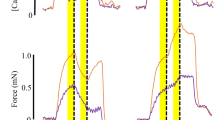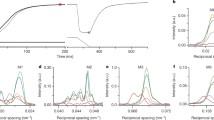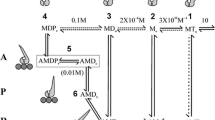Abstract
Calcium transients, monitored by aequorin, and force were recorded simultaneously during tetanie contractions of isolated frog skeletal muscle fibers. Quick length changes were applied to the fibers during contractions at sarcomere lengths on the descending limb of the length-tension relationship. Previous experiments showed that regulatory Cat2+ binding sites are apparently saturated during a plateau of tetanic force development at these sarcomere lengths. However, quick releases of greater than 4 to 5% of fiber length produced a momentary fall in the calcium transient that followed a time course similar to the redevelopment of force. The fall in the Ca2 + transient after a release was maximum at striation spacings about half way along the descending limb (2.8–2.7 Am), which suggests it is not related to an increase in the number of Ca2 + binding sites distributed uniformly along the filaments. The effect was absent or barely detectable when highly stretched fibers were released during contraction. The fall in the Ca2+ transient was unrelated to the time during a tetanus that a release was made or to the velocity of the release. One explanation of these results is that complexes between actin and myosin are broken by a sudden reduction of length, and as they reform during the recovery of force the affinity of troponín for Ca2 + increases. Quick stretch had no effect on the rapid decay of Ca2+ transients, but stretch increased peak force and slowed relaxation for almost a second after the end of stimulation. Evidently the decrease in the rate of relaxation produced by stretch is unrelated to changes in the amount of Ca2 + released or the rate of Ca2+ removal, which supports suggestions that the kinetics of muscle relaxation are determined by more than one mechanism. The apparent increase in the overall duration of mechanical activity after stretch probably results from the longitudinal inhomogeneity in the duration of activity — known to occur during relaxation — coupled with the decreased compliance of stretched fibers.
Access this chapter
Tax calculation will be finalised at checkout
Purchases are for personal use only
Preview
Unable to display preview. Download preview PDF.
Similar content being viewed by others
References
Allen, D.G. (1978). Shortening of tetanized skeletal muscle causes a fall of intracellular calcium concentration. J. Physiol. 275: 63 P.
Ashley, C.C. and Lignon, J. (1982). Aequorin responses during relaxation of tension of single muscle fibres stimulated by voltage clamp. J. Physiol. 318: 10–11 P.
Blinks, J.R., Rudel, R. and Taylor, S.R. (1978). Calcium transients in isolated amphibian skeletal muscle fibres: Detection with aequorin. J. Physiol. 277: 291–323.
Bremel, R.D. and Weber, A. (1972). Cooperation within actin filament in vertebrate skeletal muscle. Nature 238: 97–101.
Cannell, M.N. (1982). The ‘effect of temperature on the rate of fall of intracellular calcium during relaxation of frog skeletal muscle. J. Physiol. 340: 27 P.
Ceechi, G., Griffiths, P.J. and Taylor, S.R. (1981). Decrease in aequorin response of skeletal muscle produced by quick release during tetanic contraction. Proc. VII Internat. Biophys. Congr. pp. 177.
Cecchi, G., Griffiths, P.J. and Taylor, S.R. (1982). Muscular contraction: Kinetics of cross-bridge attachment studied by high frequency stiffness measurements. Science 217: 7072.
Cecchi, G., Griffiths, P.J. and Taylor, S.R. (1983). The kinetics of cross-bridge attachment studied by high frequency stiffness measurements. This volume.
Dawson, M.J., Gadian, D.G. and Wilkie, D.R. (1980). Mechanical relaxation rate and metabolism studied in fatiguing muscle by phosphorus nuclear magnetic resonance. J. Physiol. 299: 485–484.
Edman, K.A.P. (1974). In: The Physiological Basis of Starling’s Law of the Heart Ciba Foundation Symposium, vol. 24, American Elsevier, New York, pp. 112–115.
Edman, K.A.P. (1980). Depression of mechanical performance by active shortening during twitch and tetanus of vertebrate muscle fibres. Acta Physiol. Scand. 109: 15–26.
Edman, K.A.P. and Kiessling, A. (1971). The time course of the active state in relation to sarcomere length and movement studied in single skeletal muscle fibres of the frog. Acta Physiol. Scand. 81: 182–196.
Edman, K.A.P. and Flitney, F.W. (1977). Non-uniform behaviour of sarcomeres during isometric relaxation of skeletal muscle. J. Physiol. 276: 78–79.
Edwards, R.H.T., Hill, D.K. and Jones, D.A. (1975). Metabolic changes associated with the slowing of relaxation in fatigued mouse muscle J Physiol. 251: 287–301.
Fuchs, F. (1978). On the relation between filament overlap and the number of calcium-binding sites on glycerinated muscle fibers. Biophys. J. 21: 273–277.
Gillis, J.M. (1980). The biological significance of muscle parvalburnins. In: Calcium-binding Proteins Structure and Function. edited by F.L. Siegel, E.Carafoli, R.H. Kretsinger, D.H. MacLennan and R.H. Wasserman Elsevier North-Holland Inc., pp. 309–311.
Gillis J.M., Piront, A. and Gosselin-Rey, C. (1979). Parvalbumins. Distribution and physical state inside the muscle cell. Biochim. Biophys. Acta 585: 444–450.
Gordon, A.M. and Ridgway, E.B. (1978). Calcium transients and relaxation in single muscle fibers. Eur. J. Cardiol. 7/Suppl.: 27–34.
Hennekes, R., Kaufmann, R., Lab, M. and Steiner, R. (1977). Feedback loops involved in cardiac excitation-contraction coupling: Evidence for two different pathways. J. Mol. Cell. Cardiol. 9: 699–713.
Huxley, A.F. (1980). Reflections on muscle. In: The Sherrington Lectures, volume XIV, 111 pp., Princeton Univ. Press, Princeton, NJ.
Huxley, H.E. (1982). Guest Lecture. The Mechanism of force production in muscle. In: Disord- ers of the Motor Unit. edited by Schotland, D.L. John Wiley and Sons, New York, pp. 1–11.
Julian, F.J. and Morgan, D.L. (1979). Intersarcomere dynamics during fixed-end tetanic contractions of frog muscle fibres. J. Physiol. 293: 385–378.
Lehman W and Szent-Györgyi, A.G. (1978). Regulation of muscle contraction: Distribution of actin control and myosin control in the animal kingdom. J. Gen. Physiol. 66: 1–30.
Lopez, J.R., Wanek, L.A. and Taylor, S.R. (1981). Skeletal muscle: Length dependent effects of potentiating agents. Science 214: 79–82.
Pagala, M.K.D. (1980). Effect of length and caffeine on isometric tetanus relaxation of frog sartorius muscles. Biochim Biophys. Acta 591: 177–186.
Sandow, A and Zeman, R.J. (1979). Tetanus relaxation. Temperature effects and arrhenius analysis. Biochim Biophys. Acta 547: 27–35.
Snowdowne, K.W. and Lee, N.K.M. (1980). Subcontracture concentrations of potassium and stretch cause an increase in the activity of intracellular calcium in frog skeletal muscle. Fed. Proc. 39: 1733.
Somlyo, A.V., Gonzalez-Serratos, H., Shuman, H., McClellan, G. and Somlyo, A.P. (1981). Calcium release and ionic changes in the sarcoplasmic reticulum of tetanized muscle: An electron-probe study. J. Cell Biol. 90: 577–594.
Taylor, S.R. (1974). Decreased activation in skeletal muscle fibres at short lengths. In: The Physiological Basis of Starling’s Law of the Heart. Ciba Foundation Symposium, vol. 24, American Elsevier, New York, pp. 93–116.
Taylor S.R., Lopez, J.R., Griffiths, P.J., Trube, G. and Cecchi, G. (1982). Calcium in excitation- contraction coupling of frog skeletal muscle. Can. J. Physiol. Pharmacol 60: 202–209.
Taylor, S.R. and Rüdel, R. (1970). Striated muscle fibers: Inactivation of contraction induced by shortening. Science 167: 882–884.
Trube, G., Lopez, J.R. and Taylor, S.R. (1981). Calcium transients in asymmetrically activated skeletal muscle fibers. Biophys. J. 36: 491–507.
Twarog, B.M. (1976). Aspects of smooth muscle function in molluscan catch muscle. Physiol. Rev. 56: 829–838.
Weber, A. and Murray, J.M. (1973). Molecular control mechanisms in muscle contraction. Physiol. Rev. 53: 612–673.
Winegrad, S. (1968). Intracellular calcium movements of frog skeletal muscle during recovery from tetanus. J. Gen. Physiol. 51: 65–83.
Winegrad, S. (1970). The intracellular site of calcium activation of contraction in frog skeletal muscle. J. Gen. Physiol. 55: 77–88.
Yagi, N. and Matsubara, I. (1977). Equatorial x-ray reflections from contracting muscle after an applied stretch. Pflugers Arch. 372: 113–114.
Author information
Authors and Affiliations
Editor information
Editors and Affiliations
Rights and permissions
Copyright information
© 1984 Plenum Press, New York
About this chapter
Cite this chapter
Cecchi, G., Griffiths, P.J., Taylor, S. (1984). Changes in Intracellular Ca2+ Induced by Shortening Imposed during Tetanic Contractions. In: Pollack, G.H., Sugi, H. (eds) Contractile Mechanisms in Muscle. Advances in Experimental Medicine and Biology, vol 37. Springer, Boston, MA. https://doi.org/10.1007/978-1-4684-4703-3_41
Download citation
DOI: https://doi.org/10.1007/978-1-4684-4703-3_41
Publisher Name: Springer, Boston, MA
Print ISBN: 978-1-4684-4705-7
Online ISBN: 978-1-4684-4703-3
eBook Packages: Springer Book Archive




